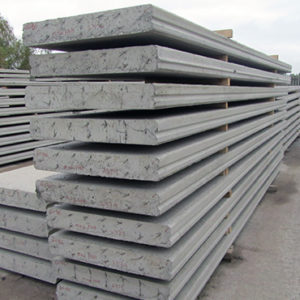It is a factory for producing ready-mix concrete panels used in ceilings (precast concrete panels). The factory produces concrete hollowcore ceiling units with a width of 600 mm and a thickness of 150 mm (250 kg/m2) and 210 mm (290 kg/m2) and in several lengths up to 8 m.

It is a factory for the production of ready-mix concrete panels used in ceilings (precast concrete panels). The factory produces concrete holocore ceiling units with a width of 600 mm and a thickness of 150 mm (250 kg/m2) and 210 mm (290 kg/m2) and in several lengths up to 8 m. It is characterized by high durability as the concrete is compacted in the molds in a regular manner using special vibrators that are controlled automatically, and controlling the degree of compaction distribution leads to avoiding granular separation and avoiding nesting, and thus it has a high degree of architecture and resistance. Also, the control of mixture ratios is done automatically according to changes in temperature and humidity, which greatly affect the quality of concrete. The resistance in holocore ceilings ranges stronger, ranging between 400-500 kg per square meter. Due to these advantages, the demand for purchasing precast concrete panels has increased and they are considered one of the basic elements in the construction process, whether public or private construction projects, according to international quality standards<br>



• Economical due to its low cost compared to traditional concrete ceilings.
• Easy to transport and install by truck equipped with a regular crane.
• Concrete panels are transported by conventional trucks equipped with a crane, or regular trucks and an independent crane are used in large projects. On site, workers install the panels on the beams, where they rest at a distance of 10 cm from each beam, and so on until all the panels are placed in the required area.
• It keeps the site clean and there are no wastes after installation. It facilitates safe and quick movement within the site.
• It keeps the air conditioning cool inside the house and vice versa in the winter, which saves electricity consumption.
• It significantly reduces sound transmission between floors due to the cylindrical voids in the hollowcore ceilings that make sound waves unable to transmit between floors, thus maintaining quietness inside the residence.
Executive Summary
Study of project services/products
Market size study.
Risk assessment study.
Technical study
Financial study.
Organizational and administrative study.

Believing in the importance of the sector, Mashroo3k Economic Consulting presents below its key indicators:

It is no secret that the Kingdom of Saudi Arabia’s 2030 vision only sought to diversify its economy and increase non-oil sector revenues in its GDP. The Kingdom has embarked on its ambitious journey; it has pumped huge sums into its infrastructure and has begun building mega projects to encourage national investments and attract regional and foreign investments.